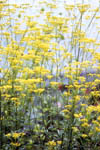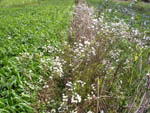|
|
|
|
|
|
| Autumn Joy Seedum –
these small flowers are very attractive to parasitic wasps, ladybugs,
and syrphid flies. |
Bronze Fennel – one
of my favorite garden/farmscaping plants. Blooms in full glory in late
summer and early fall. Blossoms are very attractive to the smaller parasitic
wasps and syrphid flies. |
Goldenrod – Goldenrod
is a very attractive pollen source for soldier beetles and ladybugs.
|
Hairy Gallasoga –
although this weed is a bane of many growers, its tiny yellow flowers
can provide ladybugs with a good source of pollen.
|
|
|
|
|
|
| Japanese knotweed – (Smartweed Family Polygonaceae)
- has extrafloral nectaries at the base of each leaf, and the delicate
featherlike white flower blossoms at the end of 10 foot stalks is an important
food source especially for flies and wasps. Japanese knotweed could be
considered a noxious weed. Other plants in this family are Pennsylvania
smartweed and Lady’s thumb. |
Jewelweed
Jewelweed/Touch Me Not – Bees and other hymenoptera like these flowers.
Found usually in cool, wet spots.
|
Queen Anne’s Lace plus Scoliid wasp |
Queen Anne’s Lace plus Coleomegilla maculata (C-Mac) ladybugs
feeding on pollen and nectar.
|
|

|
|
 |
|
| Patrina scabulosa, a great plant for larger parasitic
wasps like scoliids and tiphiids. All wasps you see in this photo are
parasitic on white grubs, these are Scolia dubia, parasitic on Green June
beetle white grubs. |
Tansy attracts a wide variety of natural enemies, from ladybugs to parasitic wasps. The leaves are similar to yarrow and may be good overwintering sites, too. |
This is a 5 year old stand of BB50 that has been selectively mowed. Note the wide variety of plants. |
|
|
|
|
|
|